
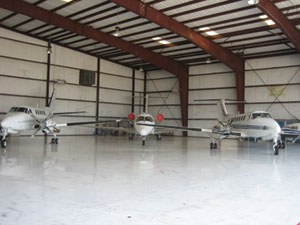
The System Plan’s Recommended Development Plan takes into consideration how the system may need to look in order to meet general aviation needs, based on the demand forecasts for 2035. Recommendations are based on current airport capacity, expansion and new facility cost estimates, benefits of public and private GA airports and the projected demand in each of the five subregions:
(north, south, east, west, central).
While there are over 400 aviation facilities in the region, 39 airports are considered essential and are in the forecast that is the basis for the Recommended Development Plan. 30 of these airports are owned by a public entity and open to the public. The other nine are privately-owned, yet still accessible by the flying public.
FAA’s airport system planning philosophy dictates the consideration of the need for new airports and/or the expansion of existing airports to support system capacity within the planning horizon. Even though measures of airport capacity are made on a regional or subregional basis, local circumstances can be important factors. For an aviation system plan, capacity is measured in the amount of aircraft storage that can be developed at each airport (landside) and the number of annual operations that can be safely conducted by arriving and departing aircraft (airside).
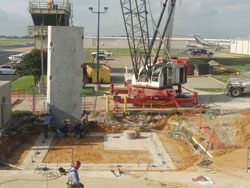
The recommended plan details an appropriate scenario for ensuring adequate and strategic capacity to meet future demand requirements. Assumed is a loss of some privately-owned airport capacity within the region by 2035, due to urban development pressures, lack of land use controls, absence of federal grant assurances, and other monetary and environmental factors. As these facilities are not mandated by the federal government to remain open to the public, the capacity they provide to region may disappear at any time.
Should a larger privately-owned airport close, the capacity shortfall is likely to require a new airport. Given this possibility, the System Plan suggests acquisition by a municipality of an existing privately-owned airport or the construction of a new facility. This facility would most likely be near the convergence of the North and Central Subregions, as if a privately-owned facility in this area were to close, a capacity shortfall would occur. To make such a decision, an airport site selection study should compare the feasibility of expanding existing facilities or developing green field sites. NCTCOG is in the unbiased position of being able to lead the planning process and to encourage potential sponsors of new airports. Future planning must be on-going and proactive, not reactive because of the length of time that is required to expand or build new facilities.
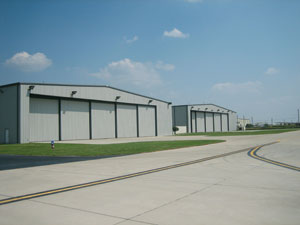
Additionally, while there is physically enough land available to provide storage space for the forecasted aircraft, there are not enough hangars on this land to store the aircraft. Much of the future development in the region will need to be directed towards aircraft storage and associated amenities. Approximately $188 million is estimated for the cost of aircraft storage, compared to the $43 for land and $40 for pavement.
The study assumes that most airport improvement projects can be funded through the traditional sources. The Texas Department of Transportation (TxDOT) utilizes FAA funding via the Block Grant Program. In Texas, GA airports that are part of the FAA’s National Plan of Integrated Airport Systems (NPIAS) are eligible for 90 percent FAA funding for most projects; a local match of 10 percent is required. While eligible, hangars and fueling systems are typically privately funded. Privately-owned airports must finance projects without federal or state assistance. Public-Private partnerships for non-eligible projects should be pursued to the benefit of all parties. Estimated infrastructure expenditures for public-use airports expected to be required through 2035 total $300 million, $25 million for privately-owned airports and $275 million for publically-owned airports.
| Recommended Plan Cost Break Down: Publicly-Owned Airports | |||||
|---|---|---|---|---|---|
| Year | Federal/State | State Only | Local | Private | Total |
| Current | $53,959,331 | $203,253 | $6,049,754 | $44,876,139 | $105,088,476 |
| 2015 | $1,061,775 | $0 | $117,975 | $12,525,000 | $13,704,750 |
| 2020 | $8,088,750 | $0 | $898,750 | $13,635,000 | $22,622,500 |
| 2025 | $1,239,300 | $0 | $137,700 | $21,990,000 | $23,367,000 |
| 2030 | $1,202,850 | $0 | $133,650 | $51,818,550 | $53,155,050 |
| 2035 | $8,175,263 | $0 | $908,363 | $47,790,000 | $56,873,626 |
| Total | $73,727,269 | $203,253 | $8,246,191 | $192,634,689 | $274,811,402 |
| Percentage | 26.80% | 0.10% | 3.00% | 70.10% | 100.00% |
The regional development and associated costs to meet GA needs are grouped into these five components:
- Land - Land includes areas that are needed to ensure the airport has the appropriate control over all safety areas required by the FAA and property needed to construct infrastructure to accommodate future demand.
- Lighting & Navaids - Lighting includes the different types of lighting and observation systems that are necessary for safe operations to and from an airport.
- Storage - Storage includes the buildings necessary to storage aircraft and terminal area for passengers and pilots.
- Pavement - Pavement includes the physical pavement expansion in the form of runways, taxiways, and aprons.
- Fuel - Fuel includes the fueling systems, such as the tanks and pumps, for aircraft of all types.
Recommendations by Subregion
Recommended Plan: Central Subregion
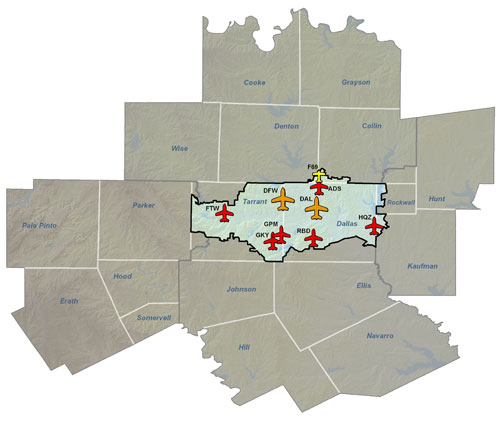
Top of Page
The Central Subregion of the System Plan is made up of Tarrant and Dallas, and parts of Collin and Kaufman counties. Of the five subregions, this geographical region is anticipated to have the highest concentration of based aircraft through 2035, utilizing over 60 percent of the available capacity. The Central Subregion will have to expand their infrastructure more than the other subregions to ensure they do not reach 100 percent capacity. It is anticipated that about $164 million in improvements will be needed through 2035.
The demand demonstrates a large need for additional aircraft storage in the Central Subregion during the forecast period, or approximately $127 million in investments for hangar space. Additionally, over $11 million will be needed to expand existing runways, taxiways, and aprons. Public airports will need to purchase a total of 230 acres at an estimated cost of $23 million for airport safety areas.
| Private Airport Costs | Public Airport Costs | Total Costs | |
|---|---|---|---|
| Land | $0 | $23,044,111 | $23,044,111 |
| Pavement | $1,925,700 | $9,472,500 | $11,398,200 |
| Buildings | $0 | $127,252,050 | $127,252,050 |
| Lighting and Navaids | $478,200 | $2,014,320 | $2,492,520 |
| Total | $164,186,881 | ||
Existing Landside Capacity Utilized: 65%
2035 Airside Capacity Utilized: 64%
Recommended Plan: East Subregion
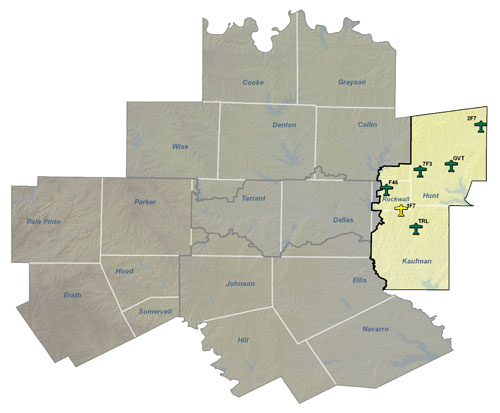
Top of Page
The East Subregion of the System Plan is made up of Hunt and Kaufman, and parts of Collin County. In order to meet the area’s needs through 2035, public and private airports should invest approximately $11.5 million. More than $5 million should be spent on pavement for runways, taxiways and aprons, and another $3.4 million should be invested in T-hangars and terminal space.
| Private Airport Costs | Public Airport Costs | Total Costs | |
|---|---|---|---|
| Land | $0 | $1,080,897 | $1,080,897 |
| Pavement | $1,822,200 | $3,391,360 | $5,213,560 |
| Buildings | $0 | $3,348,300 | $3,348,300 |
| Lighting and Navaids | $340,000 | $1,471,200 | $1,811,200 |
| Total | $11,453,957 | ||
Existing Landside Capacity Utilized: 34%
2035 Airside Capacity Utilized: 14%
Recommended Plan: North Subregion
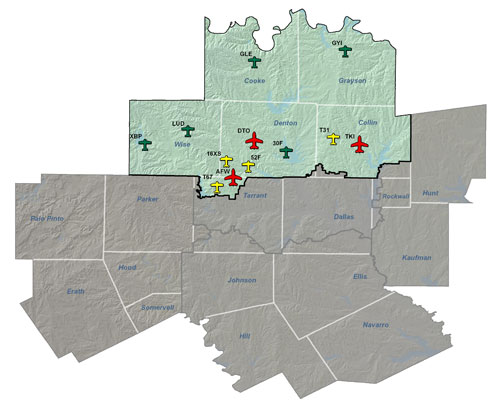
Top of Page |
The North Subregion of the System Plan is made up of Wise, Denton, Collin, Grayson and Cooke, as well as a portion of Tarrant County. This geographic area is projected to have the most available capacity in 2035. With this excess capacity, extensive opportunities for aviation-related economic development exist. In order to maximize the opportunities and meet future demand, approximately $102 million should be invested in infrastructure, including aircraft storage, pavement, and land for airport safety areas. As there are several private airports within the North Subregion, approximately $20 million of this will need to be invested by the airport owners to meet future demand for paved areas and hangar space. In order to meet future demand, $46.5 million should be invested in construction of almost 600 T-hangar bays and approximately 150,000 square feet of conventional hangar space.
Other major expenditures should be made to extend runways and taxiways and construct a parallel runway. 275 acres should be purchased by public airports for airport safety areas.
| Private Airport Costs | Public Airport Costs | Total Costs | |
|---|---|---|---|
| Land | $0 | $12,139,704 | $12,139,704 |
| Pavement | $2,050,800 | $14,724,645 | $16,775,445 |
| Buildings | $16,920,000 | $49,890,000 | $49,906,920 |
| Lighting and Navaids | $1,464,200 | $4,478,880 | $5,943,080 |
| Fuel | $75,000 | $75,000 | $150,000 |
| Total | $101,818,229 | ||
Existing Landside Capacity Utilized: 49%
2035 Airside Capacity Utilized: 43%
Recommended Plan: South Subregion
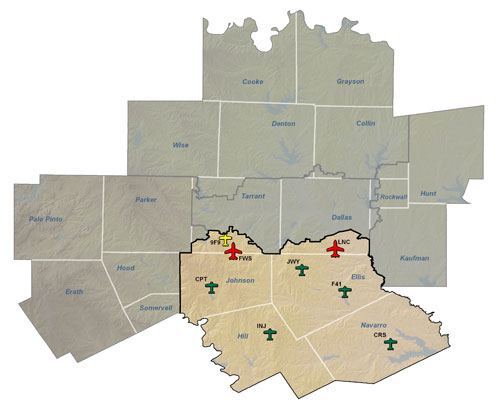
Top of Page |
The South Subregion of the System Plan is made up of Johnson, Ellis, Hill and Navarro, and the southern parts of Tarrant and Dallas counties. In order to meet forecast demand in 2035, public airports should invest approximately $14.5 million; there are no private facilities in this subregion. About $5 million should be invested in the construction of T-hangars, and another $5 million to expand runways, taxiways, and aprons.
| Private Airport Costs | Public Airport Costs | Total Costs | |
|---|---|---|---|
| Land | $0 | $3,659,864 | $3,659,864 |
| Pavement | $0 | $4,858,620 | $4,858,620 |
| Buildings | $0 | $4,800,000 | $4,800,000 |
| Lighting and Navaids | $0 | $1,155,080 | $1,155,080 |
| Total | $14,473,564 | ||
Existing Landside Capacity Utilized: 57%
2035 Airside Capacity Utilized: 26%
Recommended Plan: West Subregion
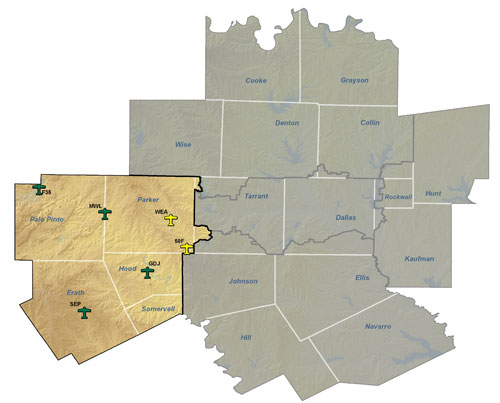
Top of Page
The West Subregion of the System Plan is made up of Parker, Palo Pinto, Erath, Hood and Somervell, and parts of Tarrant County. This Subregion will need to invest $8.5 million in improvements by 2035 to meet demand. Land acquisition can be expected to total $3.1 million and T-hangar bays should be constructed at a cost of $2.3 million. This region has the opportunity to expand its infrastructure due to the lack of geographic constraints, but will need to make up for the lack of public infrastructure.
| Private Airport Costs | Public Airport Costs | Total Costs | |
|---|---|---|---|
| Land | $0 | $3,232,872 | $3,232,872 |
| Pavement | $33,000 | $669,000 | $702,00 |
| Buildings | $0 | $2,528,000 | $2,528,000 |
| Lighting and Navaids | $513,680 | $1,525,000 | $2,038,680 |
| Total | $8,501,552 | ||
Existing Landside Capacity Utilized: 60%
2035 Airside Capacity Utilized: 18%

